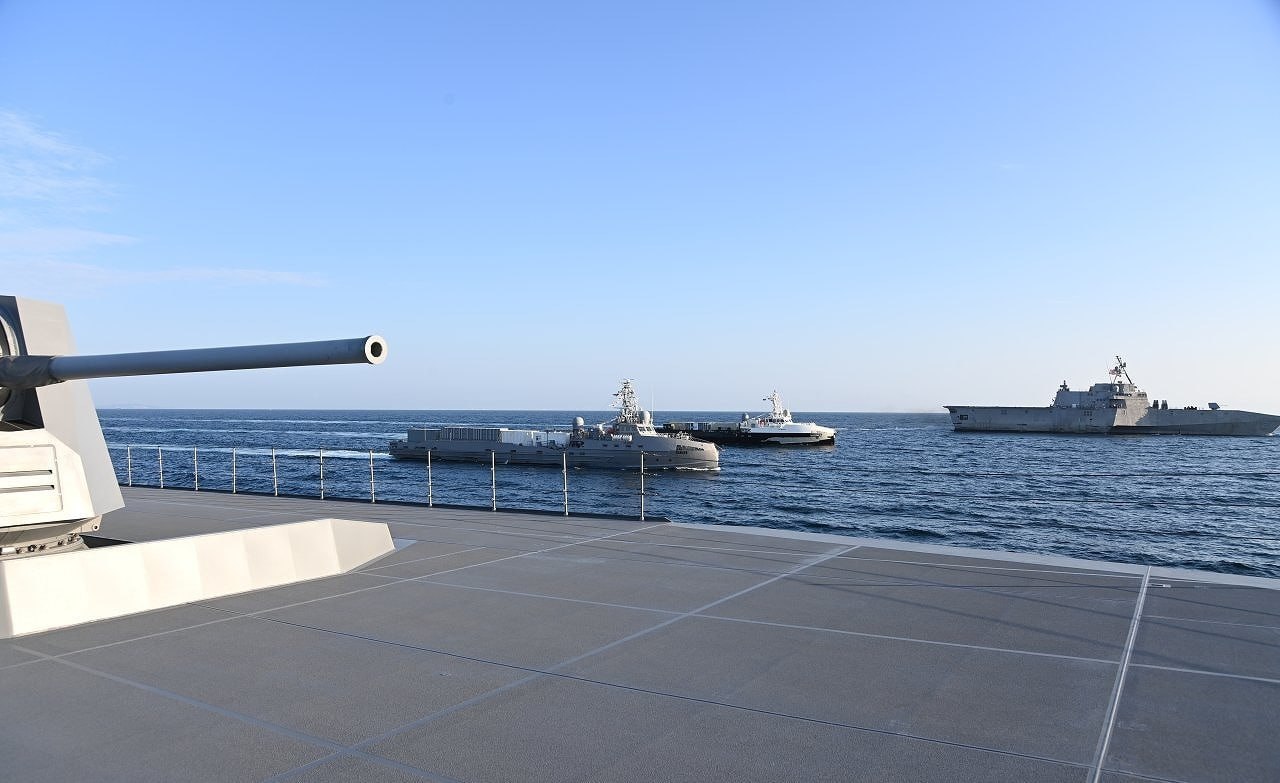The Japan Maritime Self-Defense Force (JMSDF) exercised with the US Navy’s (USN) unmanned ships and a littoral combat ship (LCS)-class vessel on September 27 in a first-of-its-kind effort.
The maritime military exercise shaped Washington’s vision of incorporating large surface uncrewed systems to assist and unburden more giant warships. It is also in line with the geopolitical situation where relations between China and Japan have been consistently deteriorating, with both accusing the other of provocation.
The Japanese Mogami-class frigate JS Kumano conducted the joint exercises with the American unmanned ships Mariner, Ranger, and the USS Oakland, an LCS vessel.
The Mariner and the Ranger are part of the USN’s Ghost Fleet Overlord project, which envisages using the unmanned surface vessels (USV) for logistics and possibly even weapons firing roles and other routine tasks, freeing up the larger destroyers and frigates for more complex missions.
The USVs can be used for anti-submarine warfare (ASW), amphibious landing, littoral combat, and limited land-attack, anti-ship and air-defense functions.
At an even broader level, USN’s Large Unmanned Surface Vessel (LUSV) and Ghost Fleet Overlord are components of more comprehensive ideas like Distributed Maritime Operations (DMO), developed to compete with China in the western Pacific.
The People’s Liberation Army’s (PLA) long-range anti-access/area-denial (A2/AD) missiles undoubtedly constitute a significant threat to the US military by prohibiting it from ever approaching Chinese coastlines.
Therefore, the US strategy would likely hinge on dispersing, coming, and striking China inside its A2/AD bubble. The use of USVs would make that function easier.
Japanese Navy Eyes On China
A statement from the Commanding Officer of the JS Kumano, Commander Izumi Atsushi, touched upon the experimental nature of the exercise and how such exercises between the navies have come to serve as a platform to test and improve various technologies, to inform future projects and doctrines.

“This is the first exercise for the JMSDF with USV, which the US Navy is testing. This ship, our FFM, and the USV that the US Navy owns are the next generation of naval vessels.
“I believe that the exercise together was an excellent opportunity to develop new ways to utilize surface vessels in the future and to strengthen cooperation between Japanese and the US naval forces in the research and development of USV.
“We, the crew of JS Kumano, will continue to work together as a team in daily training and missions to respond swiftly to all needs.” Japanese naval robotic systems, too, might figure in such future drills.
China loosely reflected in Atsushi’s statement when he said the JMSDF “maintains readiness and contributes to the peace and stability of the Indo-Pacific region not only for the defense of Japan but also for a ‘Free and Open Indo-Pacific’ in cooperation with allied and like-minded navies.”
Robot Boats Working Alongside Destroyers
It is unclear what activities and roles each ship undertook in the latest maneuvers. Any resupply, practice, or transporting goods from the hold of the USVs did not figure in any publicity material.
It is unknown if the USVs were operating fully autonomous or semi-autonomous. In the case of the latter, control of the boat could be stationed at a console on one of the large manned vessels, in this case, the Oakland.
However, these are mere speculations until the USN sheds more light on the Ghost Fleet Overlord project. A post by the JMSDF on X (formerly Twitter) said the vessels exercised together in Sagami Bay “to improve their tactical capability and interoperability with the US.”
The framing indicates the JMSDF was to be familiarized with the basic procedures and standard practices of maneuvering with and around the USV and the USN’s approaches to operating the boats while sailing in formations.
It suggests the USVs are well on their way to being made a permanent feature in small naval detachments once the tactics-training-procedures (TTP) are established.
27 SEP, JS KUMANO conducted a Japan-U.S. bi-ex with USS Oakland, USV (Unmanned Surface Vehicle) Ranger and USV Mariner in Sagami Bay to improve its tactical capability and interoperability with the USN.
It was the first exercise with USV for the JMSDF. #FOIP pic.twitter.com/6U6BHrCpOh— JMSDF Self-Defense Fleet ENG (@JMSDF_SDF_ENG) September 29, 2023
US Navy Big Plans For USVs
The two drone boats also have an Aegis combat system from Lockheed Martin and can connect with other Aegis ships in the fleet. The US Navy has test-fired SM-6 interceptor missiles from these drone boats. The Ranger was the first vessel delivered to the Navy under the program, while the Mariner was the third and was inducted in August 2022.
USVs are also anticipated to fuse with emerging concepts of other services like the US Marine Corps (USMC) Expeditionary Advanced Base of Operations (EABO) and USMC Force Design-2030.
Small, agile, and hard-to-detect Marine units on islands of friendly countries like Japan and the Philippines could be entrusted with undertaking anti-shipping fire on the Chinese Navy’s armadas in the East and South China Seas.
Resupplying these marines with ammunition and ration could be one of the roles the USVs can undertake, especially when large Arleigh Burke-class destroyers and amphibious vessels will be fending off Chinese navy missile strikes and reinforcing allies like Japan or the Philippines.
- The author can be reached at satamp@gmail.com
- Follow EurAsian Times on Google News